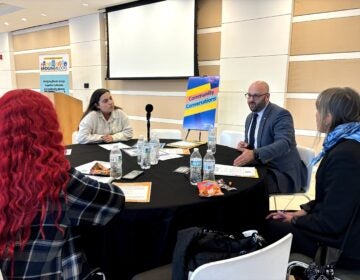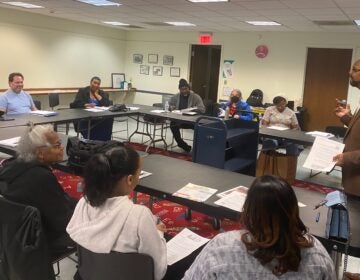Portraits through door frames, a changing Philadelphia
Knocking on doors to ask if people planned to vote in the upcoming election, I thought I could identify the pulse of the city. Turns out there are as many pulses as people.
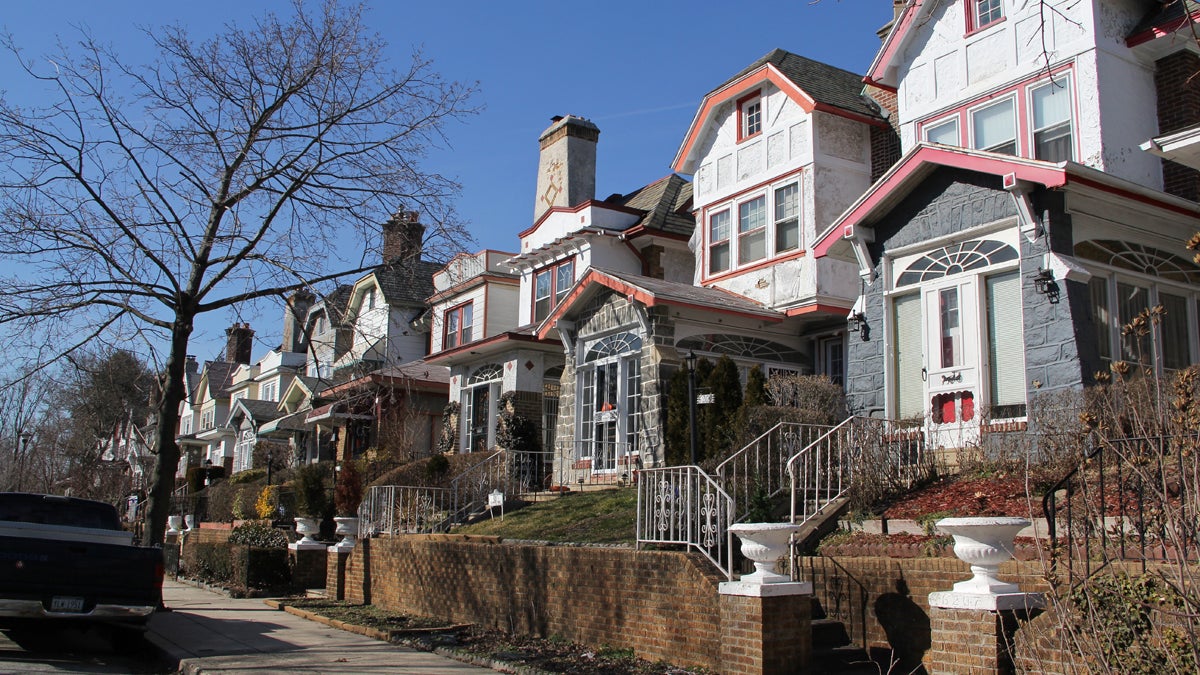
A neighborhood in West Philadelphia. (Emma Lee/WHYY, file)
From March through May, five evenings a week, I was one of those guys knocking on your door asking, “Hey! Do you plan on voting in the upcoming election?” I spent those months canvassing all over Philadelphia for the mayoral primary, speaking to 30 or 40 people each night.
I also asked a more interesting question: “What do you think is the biggest issue facing Philadelphia right now?” I thought I would be able to identify the pulse of the city. Turns out there are as many pulses as there are people. I didn’t come away with a diagnosis, but I did come away with a portrait of Philadelphia, stretched tight between a thousand door frames.
West
On my first Friday, I was assigned to Cobbs Creek. My turf ran up and down 52nd Street. It was a beautiful evening, and everyone was out on their porches.
I found one of the contacts on my list, a young bull, about 20 years old, sitting on the steps of his porch. I introduced myself and asked my questions. He regarded me with suspicion as he answered: He hadn’t decided yet who he was going to vote for, and his biggest issue was abuse by the police.
“Just yesterday, some police pulled me over around the block, told me to step out of the car, frisked me, and then took my car to the impound lot,” he said.
I asked him why.
“I don’t know. They didn’t give me any ticket.”
He had just come back from the impound lot, where he had to pay over $200 to get his car back. After telling me his story, he paused to look me up and down. “Did the police send you here?”
I stammered, “What? No!” I asked what made him think so.
“The last time the police roughed me up, someone came around here the next day talking about voting.”
Damn, I thought. That’s democracy in the 21st century.
I had a long list of contacts, but so few people were home that I had a hard time finding them. I would get someone in the family and ask for the others, and she would respond, “Nope, they workin’.” If a mother had just come back from a day shift, the daughter had already left for a night shift, and the father was sleeping off a double shift. It was slow-going.
Halfway through my shift, I met up with my colleague Mark for a break. It was Friday, the sun had been out, and his neighborhood bar was nearby, so we stopped by for a drink.
“So were you hanging out here in the ’70s?” I asked him, both of us clutching tall Heinekens.
“Man, I’ve lived in this neighborhood my whole life, and this has always been the spot.”
Mark was a West Philly cat through and through — born, raised and going on 50 years in the same neighborhood. I got him reminiscing about his days growing up, partying all over the city, week-long benders interrupted only from 9 to 5.
Back then, Mark worked as an industrial chemist. Manufacturing operations had already begun to retreat from Philadelphia, headed for the Sun Belt and overseas. But Mark could readily find employment.
“In those days, me and my friends were making good money, and we lived large.” Mark paused, staring at his Heineken. “And we didn’t have to take no jobs going around knocking on doors, neither.”
We clinked glasses to that and finished our beers.
As I zagged through my turf, I kept coming back to 52nd. The street had featured heavily in Mark’s stories. He remembered 52nd Street as an “all-hours jawn,” somewhere you could always find some action. As I walked the street near the end of my shift, I tried to imagine a younger Mark and his friends suped up in ’70’s fly, spilling out of an after-hours joint onto the street. But all the storefronts I passed were closed and darked out, and the wide sidewalks were empty under the quietly buzzing amber streetlights. I stopped every now and then to admire the bronze medallions placed periodically in the sidewalk: “52nd Street, West Philly’s Main Street.”
It was 8:55 and I needed two more contacts to make my quota. I knocked on the last door on my list. “What’s your biggest issue?”
“They gotta raise this minimum wage.”
“Great, thanks. And is your brother home?”
“Nope. He’s working till tomorrow.”
South
The next week, my turf was around 18th and Dickinson.
We parked on a north-south street. The houses on the west side of the street were old-looking red-and-brown brick row homes that might have been built in the 1930s for the city’s burgeoning working class. Staring back from the east side of the street were sleek freshly flipped condos, each the size of two old row homes, plastered over in a smooth dark-green stucco and outfitted with wide doors, slender metal handles and code locks. I imagined them filled with young professionals, working in web design, marketing or some other nexus of creativity and a college degree: Philadelphia’s creative class.
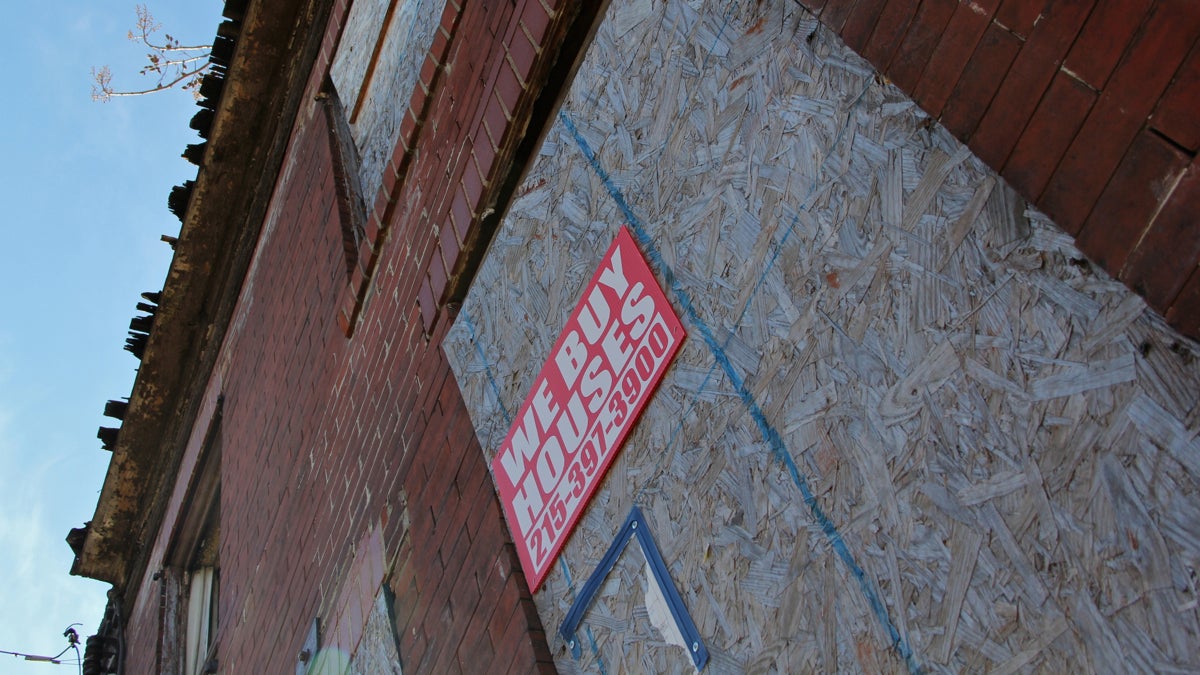
I noticed “We Buy Houses!” signs plastered all over the place, sometimes two or three to a door. On streets like Colorado, Bouvier and Cleveland, it was not uncommon to find only a third or fourth of the houses on a block still occupied, the rest left vacant or demolished. Shoulder-to-shoulder with some of the decaying row homes, though, were newly built condos and apartments. As I canvassed, I had to look down to avoid the stacks of wood and rubble piling up on the pavement, and up to look out for falling studs. For blocks and blocks around, the neighborhood rang with the demolition and construction work. It sounded like a battlefield.
At my first house I found movers carrying away furniture and boxes. I asked them if the two people on my list were home. A young guy holding a box shook his head as he walked past me toward the truck. “We’re moving their stuff out right now,” he informed me. “They won’t be back here, but I’ll pass on your pamphlet.” I handed him the pamphlet, then walked down a few doors to the next home on my list and knocked twice.
A younger guy in the next house over stepped out his front door. “They don’t live there anymore,” he told me. “Who else ya looking for?”
When I pointed out the nearby houses on my list, he updated me on their occupants.
“Those guys sold their house last month. These guys were evicted a week ago. And I’m not sure about the other two, but I ain’t seen them in a while,” he said, shaking his head. “It’s illegal to evict people during the winter, but a lot of landlords start the legal process in December so that they can evict tenants around now.”
He was on my list too, so I asked him my questions. His answer: “The biggest issue is probably education, followed by affordable housing. But young people aren’t going to stay in the city if we can’t fix the schools.”
He smiled and disappeared back into his house.
Two streets over, two women answered my knock, a mother and a daughter. They were both lifelong residents of the block, and were both happy about the redevelopment. The mother explained that vacant homes had long been her biggest concern. She had watched the neighborhood population steadily decline and was glad to see that, finally, residents were again moving in more quickly than they were moving out.
Her daughter, a high school senior, told me, “I want to see more of this development, so there can be more jobs, more activity — you know, just more stuff.”
At my next house, I found an elderly lifelong resident. When she was growing up, the neighborhood was diverse and integrated, swelling with the bustle of wartime industry. She saw racial tensions flare in the ’60s, and watched as white flight carried many of her neighbors away. As Philadelphia’s economy turned sour in the ’70s and ’80s, the neighborhood fell to drugs and crime. Still, slowly but surely, she continued to make payments on her mortgage.
Now, having finally paid it off, she was resigned to the fact that she would have to move.
“Philadelphia has been segregated for so long. I’m glad to see the neighborhood finally becoming diverse again,” she said. She was a sturdy woman who looked much younger than her 80-odd years would suggest. “But the taxes on my house are going up. The city says my property value doubled just last year alone. But I live on a fixed income. I can’t afford any more taxes!”
One man told me his biggest issue was that he wanted “less housing going up in the city.” I asked him to clarify. He stared back, dumbfounded by my question. He pointed across 18th street to a purple multi-unit condo, complete with obnoxious orange trimmings, stucco finish and vinyl paneling. Near the base of the building, though, you could still clearly see the red bricks of the condo’s predecessor.
“I want the city to stop pushing black people out of South Philadelphia,” he said.
On the way home that night, I mapped out my turf. According to Google, it straddled Point Breeze and Newbold. I asked my colleagues what they called the neighborhood we were in, though none of them were from the area.
“They call this Point Breeze,” said Terry, one of my older colleagues. The other two nodded in agreement.
I asked them if they had ever heard of “Newbold.” They all shook their head no.
When we got back to the office, I asked my friend Barry, about 20 years old, what he calls his neighborhood, knowing that I was knocking on doors just a block or two away from his house. “South Philly,” he said with a shrug.
Far Northeast
My two days of warmth in the west and south were followed by three days of miserable cold in the northeast. On the issues, Northeast Philly is a foil to the rest of the city. One pale man with fright-filled blue eyes told me the biggest issues facing Philadelphia were “racism and police-related violence.” He clarified: “reverse-racism, racism against white people,” and violent crime perpetrated “against white people and the police.”
Another curmudgeonly woman complained that affordable housing was becoming a big issue in the city.
“Oh, is housing getting more expensive out here?” I asked her.
“Not really, but the rest of the city is so expensive that it’s starting to push its trash out here!” she hissed back.
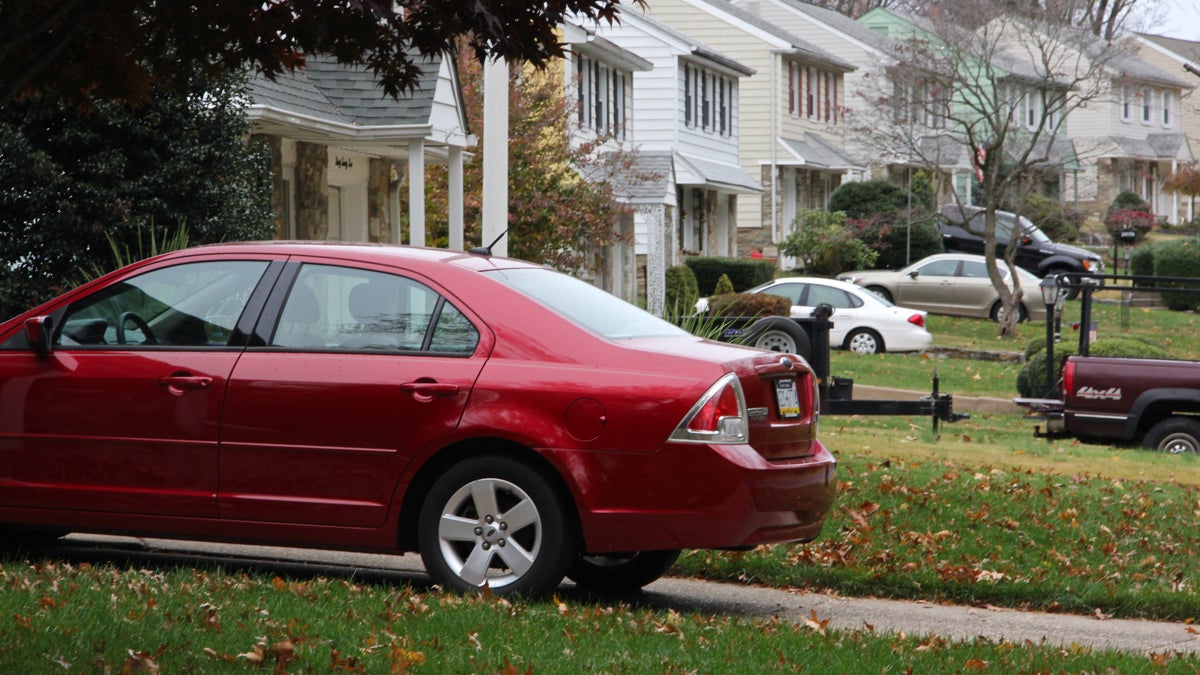
I arrived at a small house on Megargee Street. I was looking for a middle-aged woman. Answering the door instead was a man with a parted bowl cut full of fine, charcoal gray hair, bushy eyebrows, and a bulbous mustache long enough to cover his upper lip. He spoke fast and freely, and before I could ask him my questions, he told me that he and his wife were Republicans and would vote for the Republican for sure.
My list only contained registered Democrats, but I humored him.
He told me his wife couldn’t come to the door, but I persisted. He pushed open the door behind him and shouted, “SHERRI, GET OVER HERE! HURRY UP AND COME OVER HERE. THIS GUY HAS SOME QUESTIONS.” He let the door swing shut behind him and proceeded to tell me about his perspective on the issues facing the city.
The most critical issue facing Philadelphia is its abundance of “delinquents.” As this man explained it, these “delinquents” live lavishly with two phones and two Cadillacs each. They take out credit cards and spend money they don’t have, and they don’t pay their bills and are free-riding welfare. They don’t live within their means. “West Philly and North Philly are full of them, and Northeast Philadelphia and South Philadelphia are left to pick up most the tab for the tax bill.”
I asked him a few times to clarify whom exactly he was talking about. Each time, he would stutter back, “You know what I’m saying” or “You know who I’m talking about,” looking me up and down uncertainly and eyeing my moustache, as if he were trying to figure out who’s side I was on. “And I know what I’m talking about. I used to live with them,” he added. “But it got so bad that we had to move out here.”
“When did you move?”
“When I was 18.” From the look of him, the man must have been in his 60s.
“So, back in the ’70s?” I clarified.
“Yea, my parents moved us out here around then.”
A half-century later and a generation removed, the anxieties of white flight were still alive and well.
Near Northeast
Earlier in the week I had been assigned turf in the Near Northeast. I hadn’t been out to Frankford before, having only ever taken the El as far as Girard or, more recently, York-Dauphin. My territory, just north of Frankford Creek and south of Church Station, was hilly with row homes scattered up and down winding streets. As I walked down the gradient of Penn Street and turned right onto Adams Street, I was struck by the openness before me. The grass in the open spaces and splitting through the pavement was verdant and glossy.
The houses began to spread out unevenly along Adams Street — three here, four down the road, two more across the street. Between the houses were empty lots, sometimes filled with trash, junk or a storage container, or informally parked cars.
One resident suggested that, in the last 10 years, the number of Section 8 households in the neighborhood had gone up, and that absentee landlords were letting the housing stock decline rapidly. This is a commonly reported problem across the city, but is compounded in the Northeast by the fact that Philadelphia’s nearly unregulated drug and alcohol recovery homes are largely concentrated in Frankford, Port Richmond and Juniata Park. Older residents of the neighborhood regarded newer residents with suspicion and fear.
 A neighborhood in Northeast Philly (Emma Lee/WHYY, file)
A neighborhood in Northeast Philly (Emma Lee/WHYY, file)
A lot of the people I spoke to seemed to see gentrification as just five El stops away. I met one middle-aged man on Womrath Street who insisted that voting was pointless. He believed that the city had given up on his neighborhood and was now “letting it get bad so that contractors could buy up property cheap” to turn into condos and lofts. “They’ll tear down all the buildings on this street, rename it ‘Womrath Plaza,’ and none of us will be able to afford any of it,” he joked, a deep resignation beneath his chuckle. He tried to balance the blame: “It’s not like we’re doing anything to make it better. Maybe I ought to be organizing my neighbors to build this community back up, but I’m not doing that. But there’s just too much.”
After spending the night speaking with more of his neighbors, I couldn’t help but sympathize with that man’s despondent fatalism. They described a slum pit being left to waste until it could be snapped up by investors: the concentration of unregulated recovery homes, and the slumlords letting their properties deteriorate as they rented them out to poorer and poorer tenants; the ubiquitous drugs and open-air sales; the subpar charter school that many locals complained they couldn’t even get into. Two residents lamented that no one came around to remind people to vote, tell them where the polling station was (it had changed locations multiple times, unannounced), or give rides to the polls anymore.
“Community” one of them said. “That’s a South Philly thing.” She had lived in the neighborhood for 35 years.
It was hard to get people to answer the door that night. So many times, I could see that the lights were on through the window. I could see people sitting at a dinner table. I could hear the cackling of a TV playing to someone in a living room, and I knew someone was home. But no one would answer my knocks. Sometimes, a person would come to the window, shout “Who are you!?” and then disappear back behind the blinds before I could even point at my pin and say “Voting.”
I was exhausted by the time I got back to the van that night. My colleague Sam, who had lived in the Northeast for over 30 years, was already there waiting, smoking a cigarette. I grumbled to him that people out here were unwilling to spare two seconds to talk about an election that would affect their lives for the next four years. He agreed, with an incisive qualification: “But that’s not about the Northeast.”
He discharged the smoke from his lungs and stood up to his full height. “This is just the state of the city!” he said. “People are scared! They don’t even feel safe on their own doorsteps. And they’re tired. People came out for Obama, they came out for Nutter, and nothing changed. Now we’re trying to get them all up about another guy, and they’re thinking, ‘What, you’re gonna come back around here again with this shit?'”
He puffed his cigarette, then exhaled. “These are working class people. They’re coming home from long days of work, long weeks of work, and they are scared and tired.”
Southwest
Throughout my time canvassing, only three times did someone ask me for my ethnicity. I was asked first by a Cambodian man in Southwest, then again by a Malayali man in Bustleton — both times as a way into recruiting me for a pyramid scheme that targets immigrants and their children who are eager to call themselves “financial consulting entrepreneurs.” That is, eager to realize the whole American Dream in one fell swoop.
The third time, I was asked by a Liberian man in Southwest. We got to chatting, and eventually I asked him if he enjoyed living in Philadelphia.
“Hell no,” he responded emphatically. “There no justice here. If this country so rich, then why so many people so poor? People working all the time here and still don’t make enough money. And you know poor man get no justice in America.”
Besides these three instances, though, the references to my ethnicity were more oblique.
Once, I came upon a woman and three men who were chatting on a porch. I could hear them laughing about something from the top of the block. As I approached them, I looked down at my list to see if their address was on my list. By the time I looked back up, I was standing in front of their porch, and the group had fallen dead silent, each person staring at me with suspicion.
The address wasn’t on my list, but I decided to introduce myself, hoping that I might dispel the tension. “Hey, my name is Neilay. I’m just out here talking to folks about the upcoming election.”
“You gettin’ paid to do that?” the woman on the porch asked.
“Yea.”
“Where you from?” she continued.
“Philadelphia,” I responded, knowing that wasn’t the answer she was looking for.
“Mmhmm,” she nodded back at me as she frowned. The house next door was on my list, so I walked up and knocked. The whole group continued to sit in silence and stare at me as I waited. They didn’t continue talking until I stepped back down off that porch.
“And now these immigrants are coming in here taking all the jobs,” said the woman to her friends. “And then they try to tell us that they’re only taking the jobs that Americans don’t want. Bullshit!”
“Yea, and I heard the government pays them to move here too,” one of the men responded.
I couldn’t be sure that they were talking about me. But I didn’t doubt that my moustache, brown skin and foreign-sounding name had at least jogged their memories. I wanted to tell them that I was, indeed, American, but I realized it wouldn’t matter. Whether or not I was foreign to this country, I was certainly foreign to this block and foreign to them. I locked my eyes on the pavement in front of me and kept on walking.
My turf stretched up through Kingsessing towards Baltimore Ave. Unsurprisingly, rising rents and gentrification were widely cited issues. One longtime resident, however, believed that, as her older neighbors began to pass away or move, more and more properties were being rented out to “Section 8 tenants.” She complained to me about “young hoodlums” moving into the neighborhood who “play loud music and smoke marijuana.” I think the description could also fit many of the young gentrifiers who were moving into the neighborhood and renting at market rates. I know the description fits a lot of the punks I know who had moved to the area. But I kept my thoughts to myself.
On the van ride back to the office, I mentioned that an older resident had been irked by the increasing number of Section 8 residents moving into the neighborhood. Others in the van had heard similar things on their turf. All the while, Terry was mostly silent, focusing her attention on driving. We finished our debriefing and the car had fallen quiet by the time we reached I-76. Then she spoke up.
“You know, one woman said the same thing to me,” Terry said, her eyes fixed on the road ahead. “I told her that I used to be my block captain. I would go door to door every week to check in on everyone and see what they needed, visit the seniors and make sure they were ok. I would organize block cleanups and activities for the kids in the summer. Everyone on the block knew me, but nobody knew I was on Section 8. I told her to get to know her neighbors before she made assumptions about them.”
We sat in silence the rest of the ride home. There was nothing more to say.
—
Neilay Shah is a freelance journalist, writer and tutor.
WHYY is your source for fact-based, in-depth journalism and information. As a nonprofit organization, we rely on financial support from readers like you. Please give today.



